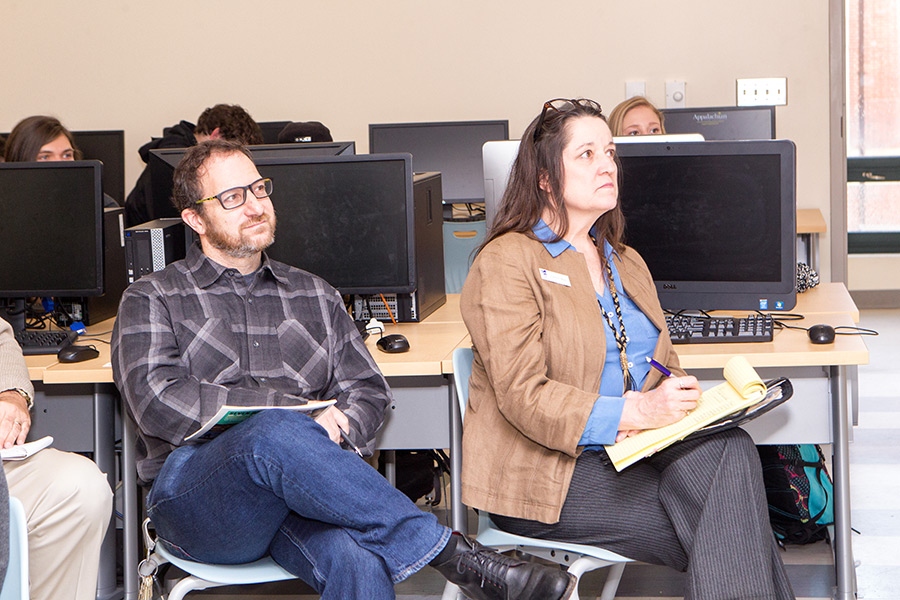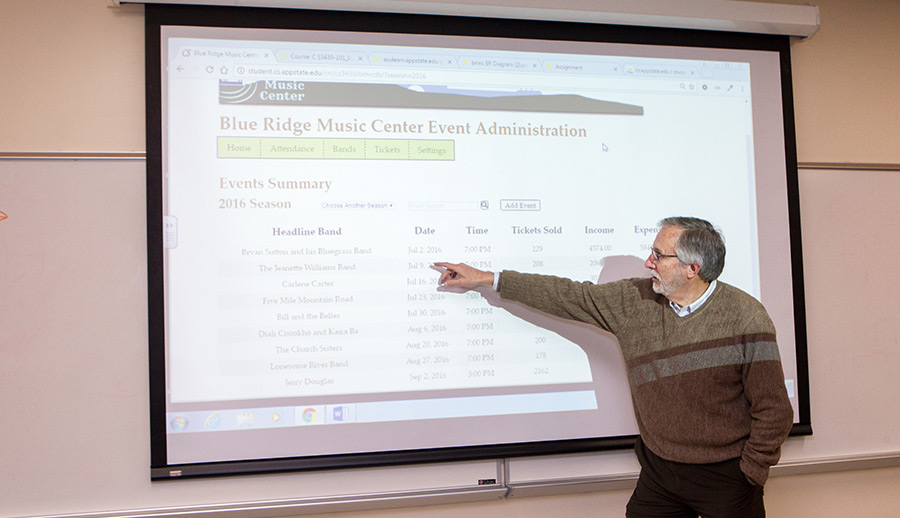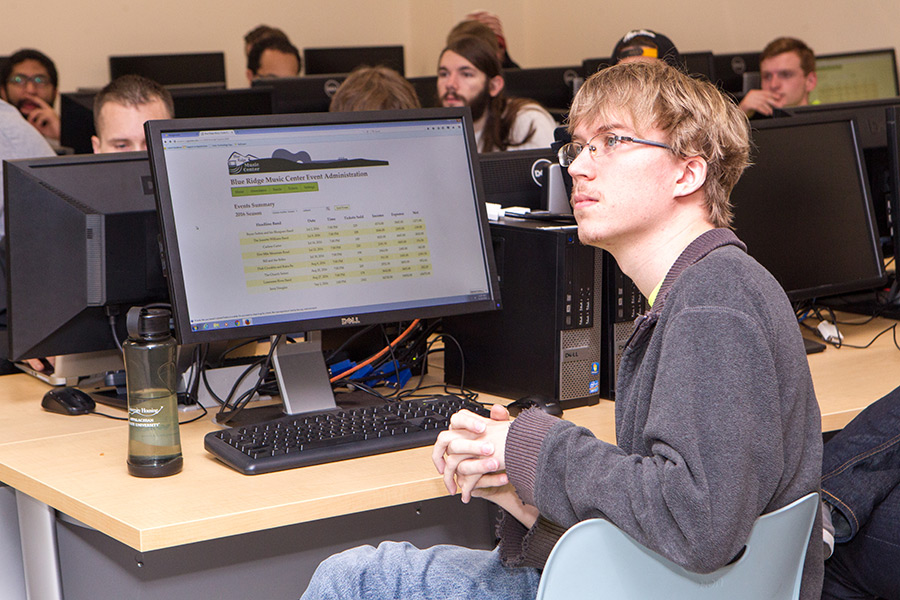BOONE, N.C.—About 75 students within Appalachian State University’s Department of Computer Science enhanced the operations of Virginia’s Blue Ridge Music Center this past semester by creating a web-based management system.
Each of the students involved in the project took one of two courses taught by Dr. Ray Russell, a professor of computer science: Client-Side Web Programming or Database Systems. The system they created, called “Blue Ridge Music Center Event Administration,” aims to streamline ticket sales, expenses and the booking of concerts for the non-profit center, which is located along the Blue Ridge Parkway near Galax, Va.
Students in classes taught by Russell often work on a major project that can be completed over the course of a semester, typically writing an application for a non-profit. The work for the Blue Ridge Music Center marked the first time that his students from more than one class worked on a project together.
Expectations for the effort were quite high. Russell called it “the closest I have come in 35 years of college teaching to reproducing a real work environment,” where individuals on a team each work on different tasks of a project and the progress of a project depends on each task being done properly.
“The dynamic of different classes working on different parts of the project was incredibly similar to that of real life,” said Aaron Parker of Statesville, a Database Systems course member and a graduate student in computer science. “Any delays from one side could cause delays on the other.”

Richard Emmett, program director of the Blue Ridge Music Center, and Carolyn Ward, CEO of the Blue Ridge Parkway Foundation, visit a class of Dr. Ray Russell, a professor of computer science at Appalachian State University, to observe a web-based management system that his students created for the Blue Ridge Music Center. Photo by Marie Freeman
The students presented their work on Nov. 29 to Richard Emmett, program director of the Blue Ridge Music Center, and Carolyn Ward, CEO of the Blue Ridge Parkway Foundation.
“Thank you all,” Emmett told the students. “It looks like a robust system. It does all we want it to do and more.”
The new management system “will help us in our decision-making,” Emmett said after the presentation.
Before Russell’s students created the center’s new management system, Emmett said, the center worked with spreadsheets only as it planned and managed performances by artists, many known nationally or internationally, including Steep Canyon Rangers, The Carolina Chocolate Drops, Lonesome River Band, The Bryan Sutton Bluegrass Band and The Quebe Sisters. This situation tended to keep the center in the dark when it came to gathering the best information for making decisions.
Now, the center can record and search for information about events, bands, attendance, income, expenses and weather. The management system’s user can find details such as how many people entered an event from a specific gate or get summary information such as net income for a specific event.
The trend data that emerge from such queries can, for example, help Blue Ridge management decide whether an October concert should be moved indoors or presented outside. Weather information will be provided by Ray’s Weather Center, which Russell owns.
The trend data can also show which genres have generated higher attendance on average or overall. It can help determine how artists’ fees correlate with ticket revenue (e.g., do higher fees equate to higher revenue from ticket sales?). It can show not only whether revenue from season ticket sales is increasing but also which types of season-ticket packages are driving that growth; the packages range from full season to the ability to pick any three shows.
So what did the Blue Ridge Music Center project entail and how did Russell’s students benefit from participating in it?
In essence, groups from each class wrote code to integrate two sides of the management system. The Client-Side Web Programming students worked on the “client” side, designing webpages, and the Database Systems students worked on the “server” side, adding functionality to the pages by hooking them up to databases.
Along the way, students further developed skills of computer scientists that make them in high demand, including an ability to work with technologies associated with web application development, mobile app development and other areas of computer science. The technologies that the students used during the project included HTML, CSS, JavaScript, jQuery, PHP and SQL.
Russell assigned specific tasks to groups working on various aspects of each side. He oversaw everything, sometimes adjusting code on one side to make it work well with code on another.
“The primary thing these students may have learned is that their code has to be correct,” Russell said. “Modern computer applications are highly integrated and developed by large teams of developers with diverse skills.”
The students’ tasks ran the gamut. Parker worked in two groups. One created a webpage for updating and displaying a particular event’s expenses. Another determined attendance numbers and attendance breakdowns in all manner of categories (e.g., comped, children, VIPs, volunteers) so that every person at an event was documented and placed in a particular database.
Jesse Sykes, a senior computer science major from Winston-Salem, worked in groups of students taking the Client-Side Web Programming course. He was part of a group that worked on the single event overview page, and he joined another group that worked on the weather pages, consolidating group members’ markup work and ensuring visual and behavioral consistency of the product.
Asked what he might tell prospective employers about the value of the Blue Ridge project, Sykes said, “The students themselves decided what roles they would assume in completing those pages. I gained experience working in a team setting in which the team itself rather than the manager of the team had to create its own working plan.”
About the Department of Computer Science
The Department of Computer Science provides a rigorous, high-quality education that prepares students for the computing industry or graduate education. It offers both a Bachelor of Science degree and a Master of Science degree in computer science.
About the Blue Ridge Music Center
The Blue Ridge Music Center celebrates the music and musicians of the Blue Ridge. It is operated by the National Park Service, with its programming coordinated through a partnership with the Blue Ridge Parkway Foundation. Established by Congress in 1997 with support from the National Council for the Traditional Arts, the center includes an outdoor amphitheater and an indoor interpretive center/theater. Its Roots of American Music Museum Exhibit highlights the historical significance of the region’s music, including its historical connections to Europe and West Africa and continued influence on popular music. The center is part of Southwest Virginia’s Crooked Road musical trail and Blue Ridge Music Trails of North Carolina.
About Appalachian State University
As a premier public institution, Appalachian State University prepares students to lead purposeful lives. App State is one of 17 campuses in the University of North Carolina System, with a national reputation for innovative teaching and opening access to a high-quality, cost-effective education. The university enrolls more than 21,000 students, has a low student-to-faculty ratio and offers more than 150 undergraduate and 80 graduate majors at its Boone and Hickory campuses and through App State Online. Learn more at https://www.appstate.edu.
What do you think?
Share your feedback on this story.













